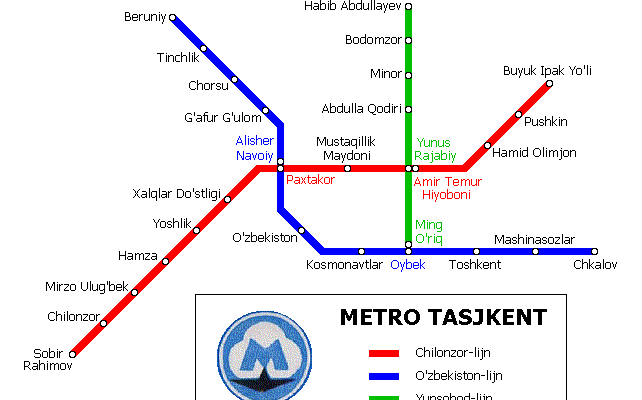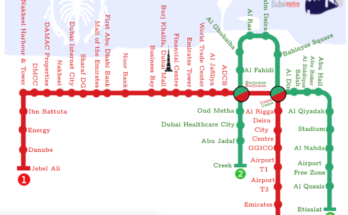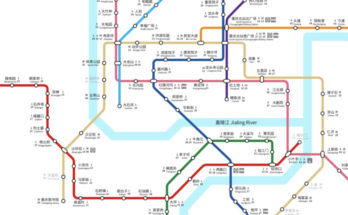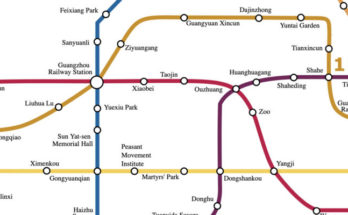Tashkent Metro is the first metro system, high-capacity public transport in Central Asia. There are only 2, the other one in the city of Almaty. This Metro is located in the modern city called Tashkent, which is the capital city of Uzbekistan. It’s serving the city since 1977. What makes this system singular is the really beautiful architecture of its stations and the depth of its stations. It’s a really shallow system.
Back in the time when USSR was still existing, this subway was the seventh subway built. It is composed of three lines, operating on more than 36 kilometers and counting 29 stations in its network.
History of The Tashkent Metro
For the beginning of the Tashkent Metro one should look back in 1966 when a big earthquake (7.5 on the Richter) hit and destroyed much of the city. 2 years later, 1968, was the year of making plans for developing the metro project. The development was coordinated taking into account the climatic condition of this particular region. This project faced numerous economic and institutional difficulties, but design and construction teams were able to overcome them.
November 6, 1977, was the day when Tashkent Metro had its grand opening. Some extensions were made in the following years. In 1980 opened Buyuk Ipak Yo’li (formerly known as Maksim Gor’kiy), in 1984 A. Navoiy – Toshkent, in 1987 the line was extended to Tashkent – Do’stlik (former Chkalov), A. Navoiy – Chorsu in 1989, Chorsu – Beruniy in 1991. The latest was the opening of the section between Ming Urik and Shahriston (formerly known as Habib Abdullayev). There are plans for further extensions, and the lines are under construction. Also, there has been a deliberation to install a fourth line, called Sirghali Line, but this installation faced delay.
Today, the Tashkent Metro has over 162,000 passengers per day. Over 59 million people travel with Metro annually.
Tashkent Metro lines and stations
Tashkent Metro consists of three lines. That would be the Chilonzor Line, Uzbekistan Line, and Yunusobod Line.
Chilonzor Line (red line)
Opened in 1977 with the last extension in 1980. It consists of 12 stations. It is both the longest (15.5 km) and line with the most stations. The station names are Olmazor, Chilonzor, Mirzo Ulug’bek, Novza, Milliy bog’, Bunyodkor, Paxtakor, Mustaqillik Maidoni, Amir Temur xiyoboni, Hamid Olimjon, Pushkin and Buyuk Ipak Yo’li.
Uzbekistan Line (blue line)
The second line is 14.8 km long and serves 11 stations. The first station was opened in 1984. By 1991 Uzbekistan Line added ten more stations. This line begins from the northwest and ends in the southwest. The first station is Beruniy, then Tinchlik, Chorsu, G’afur G’ulom, Alisher Navoiy, O’zbekiston, Kosmonavtlar, Oybek, Toshkent, Mashinasozlar and Do’stlik in the southwest part of the city.
Yunusobod (green line)
The third line represents a connection between the northern districts and the airport. This line is still under construction, providing service on the first 6.4 kilometers. The opening of the first six of the nine stations was in 2001. The stations are Mingo’rik, Yunus Rajabiy, Abdula Quodirii, Minor, Bodomzor, and Shahriston, with stations Fayzulla Xo’jayev, Yunusobod, and Turkiston that are yet to open.
Lines Schedule
The Chilonzar line has has the most traffic. During day, at rush hour, frequency of service is 2 minutes. At night, frequency of services is 10 minutes. The average is 5 minutes.
The Chilonzor and Uzbekistan lines operate between 5:00 a.m. and midnight and Yunusobod is open between 6:00 a.m. and 23:00 p.m.
Fares and tickets
You can buy the tokens from token counters at every stations. Token costs 1,200 Uzbekistani Som (0,41 USD) at the moment. The tokens are plastic and blue colored. For those people with monthly passes and free riders exist a specific gate. Afganistan veterans and veterans of the World War II travel for free. Other free riders are police officers and transit employees.
Curious facts
Expect to see impressive architecture. Each station has a unique interior. They put passengers back in the Soviet era. Amazing artwork and fast transport are what makes tourists want to travel with metro.
There are no English signs, but it is still very straightforward. Some may still have trouble understanding the exit signs, and in that case security can help.
Photographs are forbidden.
There are always a few police officers on the platforms and at all entrances who check bags and visas. It is a very safe type of transport.
The trains are ancient, but the time didn’t do the damage. Stations are clean and the system works well. The Tashkent Metro is one of the fastest ways to commute in the city.
Inhabitants are polite. Uzbeks will offer their seat to women and older population.




